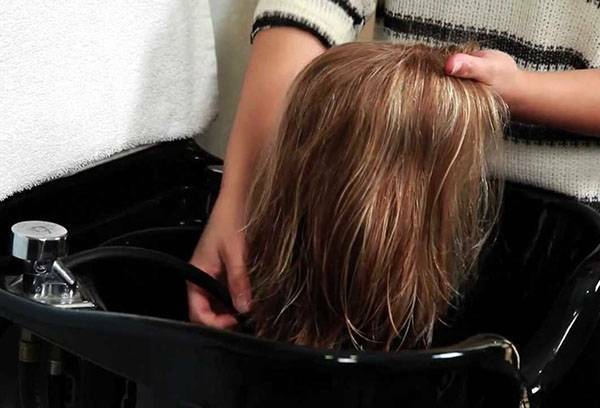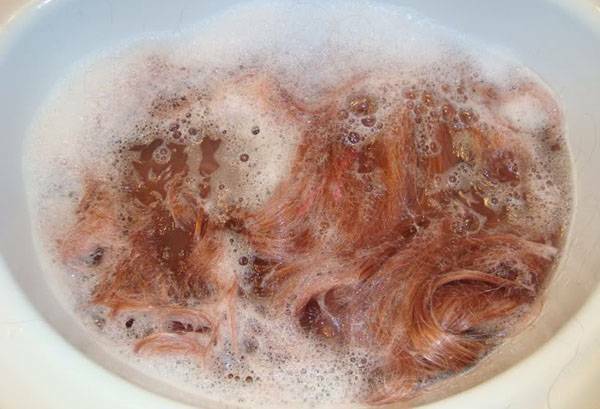Contents:
- Natural or artificial?
- Natural wig
- Synthetics
- Kanecalon and thermofiber
- Tips and recomendations
Wash the wig from artificial hair if necessary. Experts advise washing it not more than once in 45 days. The procedure requires the implementation of a number of rules that will ensure the durability of the product.
Lining is made of natural and artificial materials. It is much more difficult to erase them than to wash their hair and style their hair. When caring for a wig at home it is important to consider what material it is made of.

Natural or artificial?
The lining made from natural human hair looks very natural, which justifies its high cost. With the naked eye, it is very difficult to recognize such a wig. Natural products are made from human hair, complementing them with horse-tail hair, wool of Tibetan goats or yaks, as well as fibers of flax or hemp.
The most valuable are the handmade overlays. Hairs are attached to a cap( monture) made of special material in such a way as to repeat their natural growth. In addition to aesthetics, natural pads have other advantages: they can be cut, curled and dyed with ordinary hair dye( but it is impossible to part with these procedures).This allows you to change the image without spending money.
Inexpensive pads are made of artificial materials, such as vinyl, polyamide, acrylic. The head sweats under them, which makes the sock unbearable( especially in summer).To touch such a product is stiff and unnatural. It has a non-natural "puppet" shine. The tips of the hair are quickly confused and split. Strands are sewn with large scraps, the producers do not imitate the natural growth of the hairs.
Kanecalon wigs belong to the group of artificial, although this material is based on algae. Hair looks "alive" and elastic, the product has a natural look. It perfectly retains its shape in wet weather, but is afraid of sudden temperature changes. Only a wig made of heat-resistant fiber can withstand high temperatures.

Natural wig
Care for a wig made from natural hair is not much different from caring for your own hair. Cleaning can be done at home or entrust to professionals. Wash the product carefully, following a set of rules.
- Preparation of .Before you wash, you need to comb your hair. This is done very carefully. Use combs with wide teeth. Do not try to comb the curls: they need to be gently smoothed with your fingers.
- Wash .Collect warm water in the basin. Wet the wig and soap with shampoo for split hair. Wash the product carefully, without sudden movements. Most of all, the area of the forehead, temples and occiput becomes dirty. These zones should be washed especially intensively.
- Rinsing .To wash out shampoo it is necessary a weak pressure of cold water from roots to tips.
- Air Conditioner .Use of balm is necessary. It is applied to the tips to give the strands silky and elastic. To wash off balm it is necessary the same as shampoo.
- Drying .The wig needs to be squeezed off easily with a towel. It can not be rubbed and squeezed. Spread the strands on a dry towel and leave until completely dry. The hair dryer is practically harmless to the hair, but it can lead to deformation of the given styling.
You can make the installation yourself at home. It is allowed to use a hairdryer or a curling iron( only on the tips).If you want to change your hair, a professional hairdresser should work on the wig.

Synthetics
The procedure for washing artificial wigs( acrylic, polyamide, vinyl) differs little from the care of a natural product. Before you erase the patch at home, comb the strands of the comb or untie it with your hands. Wash the wig preferably in a basin with warm water. It is allowed to wash under the tap( under a weak pressure of warm water).Artificial hair is prone to tangling, so avoid sharp rough movements.
After washing off the shampoo, apply a conditioner or a mask for brittle hair. This will facilitate further combing and styling. Use of a hair dryer, ironing, curling and drying in the vicinity of heat sources is strictly prohibited. Put on the wrung out wig on a jar or special stand and leave to dry completely at room temperature. At home, it must be stored on a special or simulated holder.

Kanekalon and thermofiber
To make strands of kanekalon look elastic and silky, you need to follow the rules of washing, drying and styling. Wash such a product better in boiled water with a diluted shampoo for dry hair. Soak the wig for 10 minutes, then gently rub the monoture and hair with your hands. Especially carefully it is necessary to wash the occipital, temporal and frontal areas. Rinse the shampoo with cold running water.
Change the water into the pelvis. Add 2 tbsp.l.balm for dry or brittle hair. Leave the product from the kanekalon in a solution with balsam for 20 minutes. Wet the wet pad on the towel and squeeze lightly. Do not rub or twist the towel, it can tear strands and deform the wig.
Board
Drying with a hair dryer is only possible in cold air.
Thermal fiber wigs should be washed according to the same pattern. The only exception is that styling at home after drying is allowed. Thermal fiber is resistant to high temperatures, it does not frighten a curling iron or iron. However, it is better not to use the drying dryer: there is a risk of damaging the fastening of hair to montyure.

Tips and Tricks
Our hair looks silky, because it feeds on vitamins and minerals consumed by the body. Strands on patches and hairpieces do not receive internal power. They need to be washed only with qualitative means. It is allowed to use nutrient oils for tips and periodic application of natural masks.
Before you wash the wig, make sure that it is necessary. If you wear it not every day, just one wash in 3-4 months. At home, the product must be stored on special holders so that the desired hair style is not deformed.
